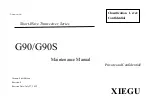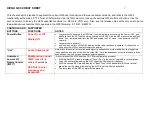
Chapter 2 • Subsystems
18
1037852-0001 Revision A
– Normal, QPSK modulation: 1/2, 3/5, 2/3, 3/4, 4/5, 5/6, 8/9,
9/10
– Normal, 8PSK modulation: 3/5, 2/3, 3/4, 5/6, 8/9, 9/10
DVB-S2 supports either CCM or ACM mode:
•
In CCM mode, all satellite routers in the network operate at
the configured modulation rate, symbol rate, and FEC rate.
•
With DVB-S2 operating in ACM mode, satellite routers can
adapt their FEC coding rate and modulation type (QPSK or
8PSK) to maximize the downlink speeds for the current
operating environment.
The DVB modulators are commercial off the shelf (COTS)
products.
Outroute redundancy
For the redundant configuration, outroute redundancy is
implemented to switch the SATGW/DVB modulator chain. The
functionality of monitoring the outroute and commanding a
switchover is implemented by the quality monitor PC (QMPC)
software component.
Timing subsystem
The timing subsystem provides the master timing for the entire
system. It also maintains the timing synchronization between the
NOC and the satellite routers. This subsystem consists of the
timing generator, the timing unit and the closed loop timing
(CLT) feature.
Timing generator
The timing generator provides the reference clock frequencies to
several NOC components, including both outroute modulators,
the timing unit, the optional automatic cross-polarization (ACP)
spectrum analyzers, and the DNCCs. It also generates a
superframe pulse for the DNCCs, the RCDs (older systems), the
timing unit, and the radio frequency terminal (RFT).
Timing unit
The timing unit provides return channel timing support for a
specific outroute. The timing unit consists of a pair of timing
satellite routers, one of which is configured as a superframe
numbering packet (SFNP) transmitter. The timing unit also
provides timing information for the optional ACP subsystem.
A timing unit measures the difference in time between the L-band
looped back signal and the signal looped back from the satellite
and provides TDMA timing information to the satellite return
channel terminals and the DNCCs within the downlink
subsystems accessible from terminals receiving this outroute.
Summary of Contents for HX System
Page 1: ...1037852 0001 Revision A September 4 2008 HX System System Overview Release 1 2 7 ...
Page 8: ... Contents viii 1037852 0001 Revision A ...
Page 10: ... Figures x 1037852 0001 Revision A ...
Page 12: ... Tables xii 1037852 0001 Revision A ...
Page 24: ...Chapter 1 Overview 12 1037852 0001 Revision A ...
Page 26: ...Chapter 2 Subsystems 14 1037852 0001 Revision A Figure 3 HX Subsystems and LAN Connections ...
Page 50: ...Chapter 4 Network security 38 1037852 0001 Revision A ...
Page 62: ...Chapter 5 Bandwidth management 50 1037852 0001 Revision A ...
Page 70: ...Chapter 6 IP features 58 1037852 0001 Revision A ...
Page 80: ...Chapter 8 Transmission features 68 1037852 0001 Revision A ...
Page 88: ...Chapter 10 HX options 76 1037852 0001 Revision A ...
Page 96: ...Appendix B Transportable Gateway TGW 84 1037852 0001 Revision A ...
Page 100: ... Acronyms and abbreviations 88 1037852 0001 Revision A ...
Page 106: ... Index 94 1037852 0001 Revision A ...
















































